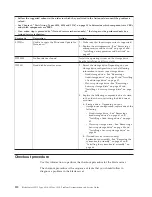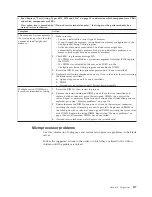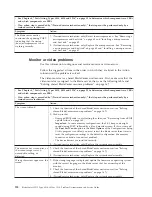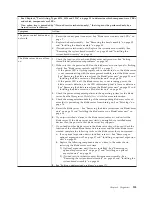
About the checkout procedure
Use this information to run diagnostics, locate error codes, and identify device
errors for the blade server.
Before you perform the checkout procedure for diagnosing hardware problems,
review the following information:
v
Read “Safety” on page v.
v
The diagnostic programs provide the primary methods of testing the major
components of the blade server. If you are not sure whether a problem is caused
by the hardware or by the software, you can use the diagnostic programs to
confirm that the hardware is working correctly.
v
When you run the diagnostic programs, a single problem might cause more than
one error message. When this happens, correct the cause of the first error
message. The other error messages usually will not occur the next time you run
the diagnostic programs.
Exception:
If multiple error codes or light path diagnostics LEDs indicate a
microprocessor error, the error might be in a microprocessor or in a
microprocessor socket. See “Microprocessor problems” on page 117 for
information about diagnosing microprocessor problems.
v
If the blade server is halted and a POST error code is displayed, see “POST error
codes” on page 86. If the blade server is halted and no error message is
displayed, see “Troubleshooting tables” on page 114 and “Solving undetermined
problems” on page 171.
v
For intermittent problems, check the error log; see “Error logs” on page 76 and
“Dynamic system analysis diagnostic programs and messages” on page 132.
v
If no LEDs are lit on the blade server front panel, verify the blade server status
and errors in the management-module Web interface; also see “Solving
undetermined problems” on page 171.
v
If device errors occur, see “Troubleshooting tables” on page 114.
Performing the checkout procedure
Use this information to perform the checkout procedure for the blade server.
To perform the checkout procedure, complete the following steps:
1.
If the blade server is running, turn off the blade server.
2.
Turn on the blade server. Make sure that the blade server has control of the
video (the LED on the keyboard/video/mouse button is lit). If the blade server
does not start, see “Troubleshooting tables” on page 114.
3.
Record any POST beep codes that sound or POST error messages that are
displayed on the monitor. If an error is displayed, look up the first error in the
“POST error codes” on page 86.
4.
Check the control panel blade-error LED; if it is lit, check the light path
diagnostics LEDs (see “Light path diagnostics” on page 127).
5.
Check for the following results:
v
Successful completion of POST, indicated by a single beep.
v
Successful completion of startup, indicated by a readable display of the
operating-system desktop.
6.
Did a single beep sound and are there readable instructions on the main menu?
v
No:
Find the failure symptom in “Troubleshooting tables” on page 114; if
necessary, see “Solving undetermined problems” on page 171.
Chapter 6. Diagnostics
113
Summary of Contents for BladeCenter HS12 Type 1916
Page 1: ...BladeCenter HS12 Type 8014 8028 or 1916 Problem Determination and Service Guide...
Page 2: ......
Page 3: ...BladeCenter HS12 Type 8014 8028 or 1916 Problem Determination and Service Guide...
Page 36: ...24 BladeCenter HS12 Type 8014 8028 or 1916 Problem Determination and Service Guide...
Page 186: ...174 BladeCenter HS12 Type 8014 8028 or 1916 Problem Determination and Service Guide...
Page 190: ...178 BladeCenter HS12 Type 8014 8028 or 1916 Problem Determination and Service Guide...
Page 198: ...186 BladeCenter HS12 Type 8014 8028 or 1916 Problem Determination and Service Guide...
Page 203: ......
Page 204: ...Part Number 60Y1601 Printed in USA 1P P N 60Y1601...
















































